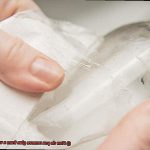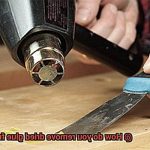Ever come across a stunning wooden masterpiece, only to be disheartened by sticky glue residue? We’ve all been there, desperately seeking a solution that won’t harm the delicate surface.
But fret not. Today, we’re embarking on an exciting journey to unveil the secrets of removing glue from wood without leaving a trace. Whether it’s remnants from a DIY mishap or stubborn labels on an antique gem, we’ve got your back.
Prepare for an intriguing twist as we plunge headfirst into the realm of wood restoration. Get ready for the ultimate guide on banishing pesky glues while keeping your cherished wooden surfaces in pristine condition.
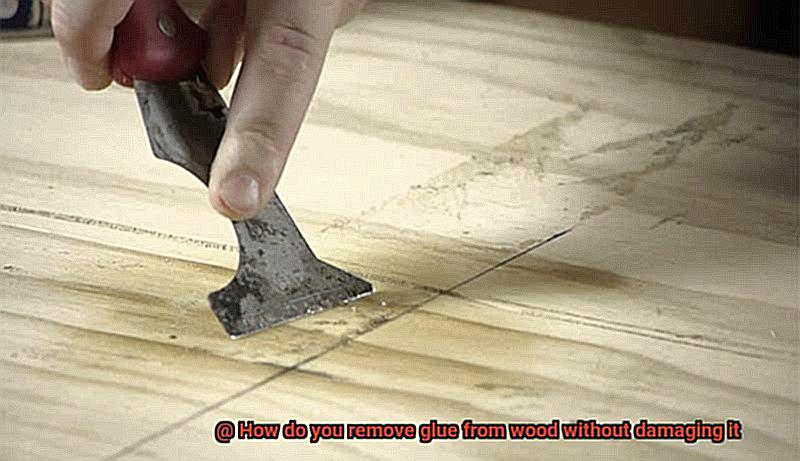
Main Points:
- The Dance of Solvents: Discover how to safely and effectively utilize solvents like rubbing alcohol, acetone, or mineral spirits. These magical potions dissolve and remove glue without tarnishing your wood’s beauty.
- Gentle Heat: Unveil the art of using controlled heat to soften adhesive bonds. From hairdryers to heat guns, various techniques cater to different glue types and wood surfaces.
- Natural Remedies: Dive into eco-friendly and budget-conscious solutions using household items like vinegar, olive oil, or even peanut butter. Surprisingly effective in removing glue without harming your precious wood.
- Time and Patience: Learn the importance of allowing substances to work their magic over time. By embracing patience, you’ll avoid aggressive scraping or rubbing that could damage the wood.
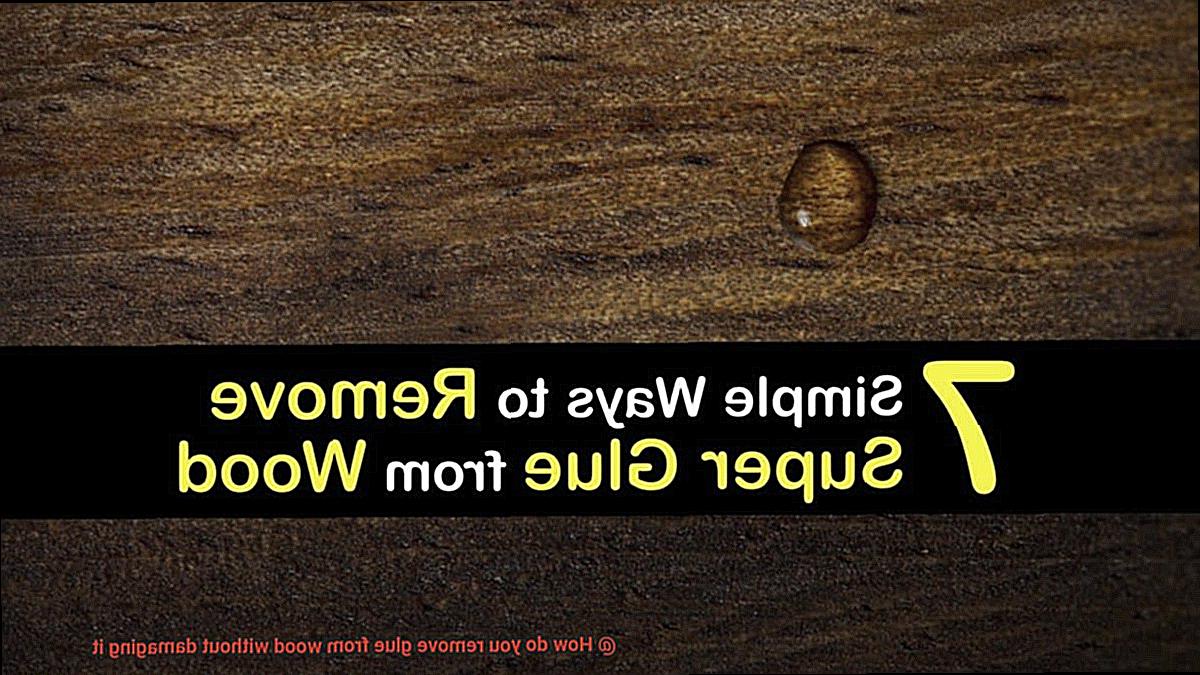
Embarking on this thrilling journey of removing glue from wood without causing harm opens up endless possibilities. Equipped with our newfound knowledge and techniques, bid farewell to stubborn adhesives while preserving your wooden treasures’ integrity and allure. So grab your apron and let’s dive into the captivating world of glue removal like never before.
What is Glue?
Contents
Prepare to embark on a captivating journey into the realm of glue, where ordinary materials transform into extraordinary creations. Whether you’re a master craftsman, a construction wizard, or simply intrigued by the wonders of adhesive, understanding the essence of glue is both enlightening and empowering.
In this comprehensive guide, we will unravel the mysteries of glue, exploring its mesmerizing components, uncovering its limitless applications, and even unveiling the art of removing it without leaving a trace on precious wooden surfaces.
Components of Glue:
Polymers: The Mighty Architects of Adhesion
Glue’s secret weapon lies in its polymers, those magnificent chains of molecules that possess an unparalleled adhesive prowess. From polyvinyl acetate (PVA) to cyanoacrylate and epoxy, these polymers forge unbreakable bonds with other materials, creating a symphony of strength and endurance.
Solvents: The Enchanting Elixirs of Flow
Ever wondered how glue effortlessly glides onto surfaces? The answer lies within its enchanting solvents. These magical elixirs reduce viscosity and transform sticky substances into fluid marvels. Like streams of water, alcohol, and acetone, they seep into the very depths of materials, ensuring an unshakeable alliance.
Additives: The Artisans of Enhancement
No masterpiece is complete without its delicate touch of perfection. In the realm of glue, additives reign supreme as masters of enhancement. These alchemists bestow strength, flexibility, and resilience upon adhesives. They pave the way for impeccable bonds and guard against the nefarious forces of mold and bacteria.
Applications of Glue:
Woodworking: Craftsmanship Elevated
In the realm of woodworking, glue emerges as the unsung hero that breathes life into wooden wonders. It unites pieces with surgical precision, creating furniture, cabinets, and ornate masterpieces that defy the boundaries of imagination. From general woodworking with PVA glue to high-stress joints fortified by epoxy, glue sets the stage for perfection.
How to Remove Glue from Wood without Damaging It
Wood is a delicate and visually appealing material that requires careful handling when removing glue. Whether you are dealing with an adhesive mishap or trying to restore an old wooden piece, it is crucial to remove glue without causing any damage. In this comprehensive guide, we will explore five effective methods that will help you safely remove glue from wood while preserving its natural charm.
Test an inconspicuous area:
Before embarking on the glue removal process, it is vital to conduct a preliminary test on a hidden area of the wood. By doing so, you can ensure that the chosen method does not harm or discolor the wood’s finish or surface. This precautionary step will give you the confidence to proceed without fear of unintended consequences.
Harness the power of heat:

One highly effective method for removing glue from wood is to utilize heat. Applying gentle heat using a hairdryer or heat gun on low settings can soften stubborn glue, making it easier to scrape away. It is essential to keep the heat source in motion and maintain a safe distance to prevent scorching or damaging the wood. By heating the glue, it becomes pliable and more manageable to remove using a plastic scraper or a soft cloth.
Employ gentle solvents:
Certain solvents can dissolve glue effectively without damaging the wood. Acetone or denatured alcohol are commonly used solvents for this purpose. However, it is crucial to test these solvents on a small area first to ensure they do not cause any harm or discoloration. Apply a small amount of solvent onto a clean cloth and gently rub the glue until it starts to dissolve. Wipe away any residue with a clean cloth and repeat if necessary.
Mechanical methods for stubborn glue:
If heat or solvents prove ineffective, mechanical methods can be employed to remove stubborn glue from wood surfaces. Using fine-grit sandpaper, gently sand away the dried adhesive until the glue is completely removed. Alternatively, a scraping tool like a putty knife can be used to gently scrape off the glue. It is crucial to exercise caution and avoid applying excessive pressure or using sharp tools that could potentially scratch or damage the wood.

Embrace natural remedies:
Nature often provides us with effective solutions, even for removing glue from wood. For smaller areas or delicate surfaces, natural household ingredients like vinegar or vegetable oil can be utilized. Vinegar can dissolve certain types of glue, while vegetable oil can soften and loosen the adhesive. Apply either substance onto a cloth and gently rub the glue until it begins to come off. Remember to test these remedies on a small area first and avoid leaving them on the wood for an extended period to prevent any potential damage.
Using Heat to Soften the Glue
Today, we unveil a secret weapon in our arsenal, a technique that will revolutionize your glue removal endeavors – the power of heat. Yes, you heard it right. By utilizing heat to soften glue, you can bid farewell to adhesive remnants without leaving a trace. So, prepare your tools and embark on this captivating journey as we explore this remarkable method.
Step 1: Assemble Your Arsenal
Before embarking on your quest for pristine wood surfaces, gather the essential tools required for this adhesive eradication mission. Equip yourself with a trusty heat gun or hairdryer, a versatile putty knife or scraper, and a clean cloth. Remember, safety is paramount; work in a well-ventilated area to ensure you inhale no fumes.
Step 2: Ignite the Heat
Now that you’re armed with the necessary tools, it’s time to ignite the flame of heat. Plug in your chosen heat tool and adjust it to a low or medium setting, unleashing a controlled burst of warmth. Hold the tool a few inches away from the stubborn glue, aiming your thermal assault precisely at the heart of the adhesive. Move the tool back and forth with a rhythmic motion, ensuring even distribution of heat. Patience is key; avoid dwelling in one spot for too long to prevent any potential harm to the delicate wood.
Step 3: The Marvelous Metamorphosis
As you unleash the transformative power of heat upon the once indomitable glue, prepare to be amazed. Behold as the adhesive succumbs to the gentle embrace of warmth, surrendering its stubborn grip and becoming pliable. This is your cue to introduce the putty knife or scraper, employing their finesse to delicately lift away the softened adhesive. Exert caution and grace, navigating the surface with precision to preserve its unblemished appearance.
Using Solvents and Adhesive Removers
In our quest for flawless wood surfaces, we’ve explored the power of heat to conquer stubborn glue. Now, prepare to be amazed as we delve into the world of solvents and adhesive removers. With these magical potions at your disposal, you can bid farewell to pesky glue without harming your beloved wood. So, grab your lab coat (just kidding.) and let’s embark on this transformative journey.
Test, Test, Test: Ensure a Drama-Free Experience
Before venturing into the realm of glue removal, it’s essential to conduct a small-scale test with solvents or adhesive removers. This precautionary step guarantees that no unsightly discoloration or damage occurs. Safety first, my friends.
Ace It with Acetone: The Superstar Solution
When it comes to vanquishing glue, look no further than acetone. This readily available solvent effortlessly dissolves a wide range of adhesives. Simply apply acetone to a cloth or sponge, gently rub the glue until it loosens, and wipe it away. Abracadabra. Sticky residue begone.
Isopropyl Alcohol Magic: A Gentle Yet Effective Ally
Another trusty solvent in our arsenal is isopropyl alcohol. This magical elixir works in harmony with wood surfaces, mirroring the prowess of acetone. Apply it using a cloth or sponge for optimal results, and watch the glue surrender to its gentle power.
Ventilate and Stay Safe: Breathe Easy
While solvents work wonders in glue removal, it’s crucial to use them in well-ventilated areas to avoid inhaling any fumes. Remember, safety should never take a backseat during your DIY adventures. Also, minimize prolonged contact with solvents for your own well-being.
The Mighty Goo Gone: A Specialized Solution
For those seeking a superhero adhesive remover, let us introduce you to Goo Gone. Formulated specifically for various surfaces, including wood, this mighty product eradicates sticky residues in a flash. Apply it directly to the glue, wait a few minutes, and wipe away with a cloth or sponge. Easy-peasy, lemon squeezy.
Scraping Away the Glue
Prepare to witness the delicate dance of adhesive removal as we uncover the secrets to scraping away glue from wood surfaces without leaving a trace. Armed with a trusty scraper and a dash of patience, you’ll be able to bid farewell to stubborn glue and restore your beloved wood to its former glory. Join us as we dive into this artful process and learn how to free your wood surfaces from the clutches of sticky residue.
Timing is Everything:
To ensure successful glue removal, it’s crucial to let the glue dry completely before scraping. Attempting to remove wet or tacky glue will only lead to frustration and spread the mess further. Exercise patience and let the glue reach its full potential before beginning the delicate dance.
The Right Tools for the Job:
Equip yourself with a putty knife or scraper for this intricate task. These trusty companions will help you navigate the intricate contours of your wood surface without causing any harm. Remember to use a tool with a sharp edge that won’t leave unwanted marks on the wood.
The Art of Scraping:
With gentle precision, slide the edge of your chosen tool under the dried glue, applying light pressure. Slowly work your way along the glue line, lifting and scraping it away bit by bit. Avoid digging too deep into the wood surface to prevent scratches or gouges.
Angles and Heat:
Mastering this dance requires holding your scraper at a slight angle, ensuring it glides smoothly without digging into the wood. For stubborn or thick glue, apply gentle heat using a hairdryer or heat gun. The warmth softens the glue, making it easier to scrape off.
Keeping it Clean:
As you gracefully scrape away the glue, periodically clean the blade of your scraper with a cloth or paper towel to remove any adhesive residue. This simple act prevents transferred glue from leaving marks on the wood surface, maintaining its pristine appearance.
Battling Persistent Residue:
In some cases, even after your finest performance on the scraping stage, adhesive residue may persist. Fear not; additional methods like solvent application or sanding can come to the rescue. However, use these techniques sparingly and with caution to avoid unintended damage.
Sanding as a Last Resort
In our previous discussion, we uncovered the art of adhesive removal, mastering the delicate dance of scraping away glue from wood surfaces. But what if all else fails? Fear not, for today we journey into the realm of sanding as a last resort. While sanding may seem like a simple solution, it must be approached with caution to safeguard your cherished wooden surfaces. So, grab your sandpaper and embark with us on why sanding should be your final option.

Understanding the Risks:
Sanding involves using abrasive materials to remove glue, potentially stripping away layers of the wood’s surface. This is where the principle of “less is more” truly applies. Before reaching for that sandpaper, consider gentler methods first.
Heat and Solvents: The Gentle Alternatives:
Before resorting to sanding, explore the wonders of heat and solvents to break down glue without causing extensive damage. Gently apply heat from a hairdryer or low-setting heat gun to soften the glue, making it easier to remove. Certain solvents like acetone or rubbing alcohol can also dissolve specific types of glue. Prioritize caution by testing any solvent on an inconspicuous area to ensure it won’t harm your wood.
Scraping: An Artful Touch:
If heat and solvents fail to yield results, enter the realm of delicate scraping. Employ a plastic or wooden scraper to gently lift off the glue from the wood’s surface. Exercise restraint in applying pressure, as excessive force can result in unsightly scratches or damage.
The Final Frontier: Mastering Sanding Techniques:
When all other options have been exhausted, it’s time to bring out the sandpaper. But wait. Before diving headfirst into sanding, equip yourself with the right tools and approach the task with finesse.
Natural Household Ingredients for Smaller Areas
Picture this: you accidentally spill glue on your pristine wooden surface. Panic sets in as you contemplate the daunting task of removing the sticky mess. But fear not. In this enchanting guide, I will reveal the awe-inspiring abilities of natural household ingredients to conquer glue stains in smaller areas. From the mighty vinegar and gentle baking soda to the citric savior lemon juice and soothing olive oil, get ready to witness the magic of these miraculous remedies. So grab your cleaning gear, and let’s embark on a journey into the realm of natural solutions.
Vinegar – The Mighty Acid:
Vinegar, a humble pantry staple, possesses extraordinary powers when it comes to breaking down adhesive bonds. Behold the steps to harness its might:
- Immerse a cloth in vinegar and lay it upon the glue stain.
- Allow the vinegar to penetrate the stubborn adhesive for a few minutes.
- Employ a soft brush or sponge to gently scrub the area.
- Repeat as necessary until every trace of glue vanishes.

Baking Soda – The Gentle Abrasive:
Like a loyal companion, baking soda knows just how to lift glue from your wooden surfaces with its gentle abrasive nature. Follow these simple rituals:
- Mix baking soda with a small amount of water, creating a paste.
- Apply the paste directly onto the glue stain, ensuring thorough coverage.
- Grant it a few minutes to work its magic.
- Employ circular motions with a soft cloth or sponge to gently scrub away the adhesive.
- Rinse triumphantly with water once every last bit of glue bids farewell.
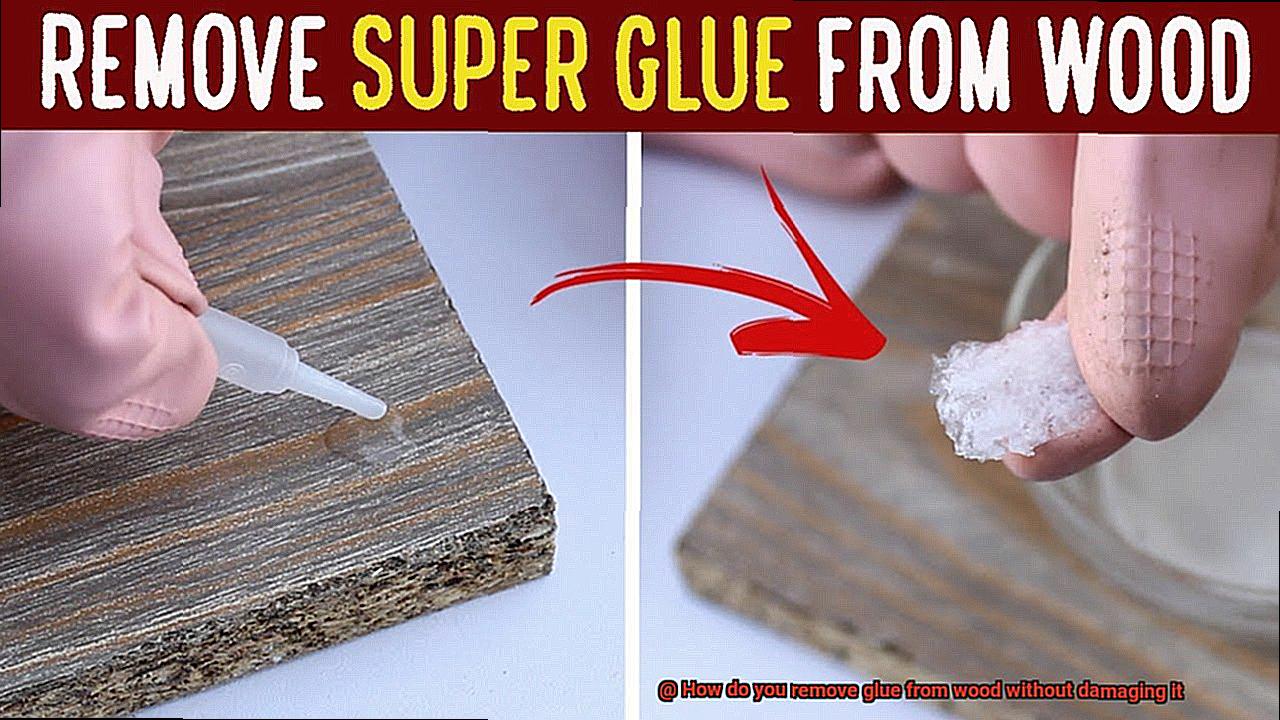
Lemon Juice – The Citric Savior:
Beyond its zesty allure in culinary endeavors, lemon juice harbors citric acid, an ally in effortlessly dissolving adhesive bonds. Let’s harness its power:
- Extract fresh lemon juice and saturate a cloth or sponge.
- Vigorously rub the lemon juice onto the offending glue stain.
- Allow the tangy elixir to work its wonders over a few short minutes.
- Employ a soft brush or sponge to tenderly scrub the area.
- Bid adieu to the glue remnants with a refreshing rinse of water.
Olive Oil – The Soothing Savior:
Prepare to be astounded as olive oil, a kitchen essential, reveals its hidden talents in gently softening adhesive and simplifying glue removal:
Tips for Safely Removing Glue from Wood
Wood is a stunning and resilient material that adds warmth and sophistication to our living spaces. However, when glue becomes stuck on wood surfaces, it can be a real headache to remove without causing damage. In this article, we will delve into the importance of taking precautionary measures when removing glue from wood in order to preserve the beauty of your wooden surfaces. We will provide you with valuable tips to ensure that your wood remains unblemished throughout the removal process.
Identify the Type of Glue:
Before embarking on the task of removing glue from wood, it is crucial to identify the type of glue that has been used. Different glues require different removal methods. Common types of glue used on wood include super glue, wood glue, epoxy, and white glue. Each type of glue has its own set of characteristics and may require specific techniques for safe and effective removal.
Test a Small Area:
In order to avoid any unwanted damage or discoloration, it is highly recommended to test your chosen removal method on a small, inconspicuous area of the wood first. This preliminary test will enable you to assess whether the method is suitable and safe for use on the entire surface. Remember, an ounce of prevention is worth a pound of cure.
Use Heat:
One highly effective method for removing glue from wood involves applying heat. This can be achieved by using a hairdryer set on high heat or a heat gun on its lowest setting. The application of heat softens the glue, making it easier to scrape off with a plastic scraper or putty knife. It is important to keep the heat source constantly moving to avoid overheating the wood, which could potentially cause irreparable damage.
Apply Solvents or Adhesive Removers:
For stubborn and dried-on glue, solvents or adhesive removers can be a game-changer. Household items such as rubbing alcohol, acetone, or mineral spirits can be highly effective in breaking down the glue and allowing it to be wiped away. However, it is crucial to test these substances on a small area first to ensure that they do not cause any harm or discoloration to the wood.
Gently Scrape Off Excess Glue:
After applying heat or solvents, it is time to gently scrape off the excess glue using a plastic scraper or putty knife. It is important to exercise caution and avoid applying excessive pressure, as this can result in unsightly scratches or gouges on the wood surface. Take your time and work patiently – with gentle scraping, the glue should gradually come off.
YztA13T2EQw” >
Conclusion
Removing glue from wood without causing damage can be a tricky task, but with the right techniques and tools, it is possible to achieve success.
One method is to use heat to soften the glue, making it easier to scrape off. This can be done by applying a hot iron or using a hairdryer on a low setting.
Another option is to use solvents such as acetone or rubbing alcohol. These substances can dissolve the glue, allowing it to be wiped away gently.
It’s important to test these solvents on a small, inconspicuous area of the wood first to ensure they don’t cause any discoloration or damage. Additionally, using a plastic scraper or putty knife can help remove the softened glue without scratching the surface of the wood.
Remember to work slowly and carefully, applying gentle pressure as you go. Once all the glue has been removed, clean the wood with a mild soap and water solution and dry it thoroughly.
Finally, consider applying a protective finish or wax to restore the wood’s shine and protect it from future damage.



